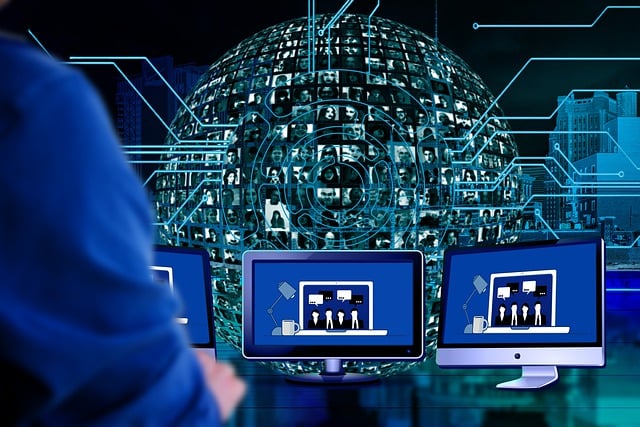Facial recognition technology, powered by machine learning algorithms and high-resolution imaging, significantly enhances CCTV surveillance systems' capabilities. By pre-processing facial images and comparing them to databases, it accurately identifies individuals in public spaces, airports, and offices. This integration offers advantages in public safety and crime prevention but raises ethical concerns regarding privacy and accuracy, especially with potential biases impacting marginalized communities. Future advancements promise improved accuracy and wider integration into daily life and critical infrastructure, revolutionizing security measures through AI-powered threat prediction.
Facial recognition technology is transforming advanced identification methods, particularly within CCTV surveillance systems. This powerful tool leverages intricate algorithms and image analysis to verify or identify individuals with remarkable accuracy. By exploring the mechanics of facial recognition, this article delves into the multifaceted benefits it offers for enhancing security in CCTV surveillance systems. We’ll also navigate ethical considerations, existing challenges, and future prospects, including technological advancements poised to reshape identification practices.
Understanding Facial Recognition Technology: How It Works
Facial recognition technology has emerged as a powerful tool for advanced identification, revolutionizing how we approach security and authentication. At its core, this technology leverages sophisticated algorithms and machine learning to analyze and match facial features from digital images or video frames. When integrated into CCTV surveillance systems, it enables real-time identification of individuals, enhancing the accuracy and efficiency of monitoring environments such as public spaces, airports, and corporate offices.
The process begins with capturing high-resolution facial images, which are then pre-processed to enhance key points like eyes, noses, and jaws. Advanced algorithms compare these points against a database of known faces, generating a score that indicates the level of similarity. This score is compared against predefined thresholds to make accurate identification decisions. The technology’s accuracy has significantly improved over time due to the continuous refinement of algorithms and access to vast datasets, making it a reliable solution for enhancing security protocols in various sectors.
Benefits of Implementing Facial Recognition in CCTV Surveillance Systems
The implementation of facial recognition technology in CCTV surveillance systems offers numerous advantages, revolutionizing how we approach public safety and security. One of its key benefits is enhanced accuracy and efficiency in identifying individuals within a crowd or dense area. With traditional methods, distinguishing faces can be challenging, leading to potential errors or delays in identification. However, advanced facial recognition algorithms can swiftly capture and analyze unique facial features, ensuring more precise and immediate results.
Moreover, integrating facial recognition into CCTV systems provides an effective means of monitoring high-risk areas, preventing crimes, and aiding in investigations. It enables law enforcement agencies to create robust databases, cross-referencing known criminals or persons of interest with real-time footage. This capability can significantly contribute to proactive crime prevention, quick response times, and successful prosecutions, ultimately enhancing the overall security of communities.
Ethical Considerations and Challenges in Using Facial Recognition
The widespread adoption of facial recognition technology, particularly in advanced identification and CCTV surveillance systems, raises significant ethical considerations. One major challenge is privacy invasion; this technology can track and identify individuals in public spaces, potentially infringing on personal freedoms. There’s a delicate balance between enhancing security through efficient identification and safeguarding individual privacy rights.
Another concern revolves around accuracy and potential bias. Facial recognition algorithms are not infallible; they can be influenced by factors like race, gender, age, and lighting conditions, leading to misidentification or false positives. This raises questions about fairness in law enforcement and surveillance applications, especially when these errors disproportionately impact marginalized communities. Ensuring the technology is developed and deployed responsibly is crucial to mitigating these challenges.
Future Prospects: Advancements and Their Impact on Identification Methods
The future of facial recognition technology promises exciting advancements that will significantly shape identification methods, especially within the realm of CCTV surveillance systems. With continuous innovation, algorithms are becoming increasingly sophisticated, capable of recognizing faces in diverse environments and conditions, enhancing accuracy rates. This evolution ensures that what was once a niche application can now be integrated into everyday life and critical infrastructure, from public safety to transportation hubs.
These technological leaps will enable more efficient and comprehensive identification processes, making it easier for law enforcement to track individuals and for facilities to manage access. Advanced facial recognition systems, powered by AI, may even predict potential threats or anomalies in real time, revolutionizing security measures. As this technology continues to refine itself, its impact on how we identify and verify individuals will only grow more profound, offering unprecedented levels of precision and efficiency in various sectors.
Facial recognition technology is transforming the landscape of identification, offering unprecedented benefits for enhanced security in CCTV surveillance systems. While ethical considerations demand careful navigation, future advancements promise even more sophisticated and accurate methods. As we delve into these innovations, it’s crucial to balance progress with privacy, ensuring that facial recognition serves as a tool for good, revolutionizing identification without compromising individual rights.
